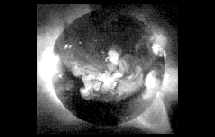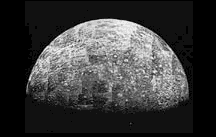
The Soft X-ray Telescope took this space image of the Sun on the Japan/US/UK Yohkoh Mission in 1992.
Sun
The Sun, the star at the center of our solar system, is about 5 billion years old. The closest star to Earth, it is 145 million km distant (one Astronomical Unit, or AU). The next closest star is 300,000 times further away. Our Sun supports life on Earth and affects the seasons, climate, weather, currents in the ocean, and circulation of the air in the atmosphere.The Sun is some 333,400 times more massive than Earth (mass = 1.99 x 1030 kg), and contains 99.86 percent of the mass of the entire solar system. The ionized gas in the Sun is held together by gravitational attraction, which produces immense internal pressure and high temperatures (more than a billion times greater than Earth's atmosphere).
Inside the Sun's core, temperatures reach 16 million degrees K, which is sufficient to sustain thermonuclear fusion reactions. The total energy generated is 383 billion trillion kilowatts/second (equivalent to 100 billion tons of TNT exploding each second). Radiative and convective zones extend from the core to the surface where the temperature decreases from 8 million to 7,000 degrees K, and the density decreases from 20 g/cm3 to 4 x 10-7 g/m3. A photon takes about 10 million years to escape from the dense core to reach the surface of the Sun.
The Sun's surface, or photosphere, is the visible, 500 kilometer-thick layer of escaping radiation, light, and Sun spots. Beyond the photosphere is the chromosphere, which appears during total solar eclipses as a reddish rim of hot hydrogen atoms. The corona extends outward forming the solar wind that sweeps charged particles to the edge of the solar system.

This false-color photomosaic of Mercury is composed of images taken by Mariner 10 in 1974
Mercury
The planet Mercury is the closest to the Sun, orbiting within 46 million km to the Sun at its closest point. Because Mercury rotates on its axis once every 58.9 days and circles the Sun once every 87.9 days, Mercury rotates exactly three times around its axis for every two orbits around the Sun. If you wanted to stay up for one solar day on Mercury (sunrise to sunrise), you would be awake for two Mercurian years (176 Earth days). The surface temperature has the greatest temperature range of any planet or satellite in our system, reaching 427°C on the day side, and -183°C on the night side.Smaller than all the other planets, except for Pluto, Mercury is about one-third the size of Earth. This planet has a magnetic field, although Earth's magnetic field is considerably stronger. However, the planet's density (5.4 g/cm3) is about the same as Earth's. Scientists think the density indicates an enormous iron core composing some 75 percent of Mercury's diameter. A rocky mantle and crust only about 600 km thick surrounds the core. When the core and mantle cooled, the radius of the planet reduced by two to four kilometers. The probably result of the planet's crust shrinking is Mercury's unique system of compressive fractures.
Only half of the surface of Mercury has been seen by spacecraft. The heavily cratered upland regions and large areas of smooth plains that surround impact basins resemble the surface of the Moon. Fine-grained soil covers Mercury's surface. Unlike the Moon, regions of gently rolling, smooth plains are the planet's major type of terrain. Eruptions of lava within and surrounding large impact craters formed these smooth plains.